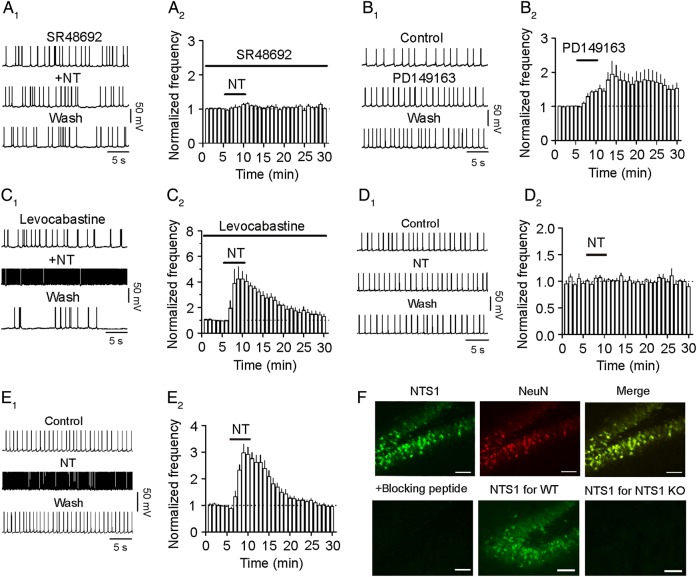Figure 3.
NT increases AP firing frequency via the activation of NTS1 receptors. (A1,A2) Application of the NTS1 antagonist, SR48692 (1 µm), almost completely blocked NT-induced facilitation of AP firing frequency. (A1) APs recorded before, during, and after the application of NT in the presence of SR48692. (A2) Pooled time course of the AP firing frequency in response to NT in the presence of SR48692. Data were shown in the same fashion thereafter. (B1,B2) Bath application of the NTS1 agonist, PD149163 (0.5 µm), significantly increased AP firing frequency. (C1,C2) Pretreatment of slices with and continuous bath application of the NTS2 antagonist, levocabastine (30 µm), did not alter significantly NT-induced transient enhancement of AP firing frequency. (D1,D2) Bath application of NT to slices cut from NTS1 KO mice failed to augment AP firing frequency. (E1,E2) Bath application of NT to slices cut from NTS2 KO mice still augmented AP firing frequency. (F) The dentate gyrus expressed NTS1 receptors. Upper left: immunostaining for NTS1 in the dentate gyrus GCs of rats; upper middle: immunostaining for the specific neuronal marker, NeuN, in rats; upper right: merged micrograph to show the expression of NTS1 in the dentate gyrus GCs of rats; lower left: no immunoreactivity was detected in the dentate gyrus of rats when NTS1 antibody was pre-adsorbed with the specific blocking peptide. Lower middle: immunostaining for NTS1 in the dentate gyrus GCs of WT mice. Lower right: no immunoreactivity was detected in the dentate gyrus GCs of NTS1 KO mice. Scale bar: 50 µm.

